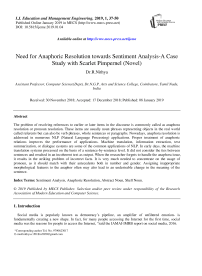Need for anaphoric resolution towards sentiment analysis-a case study with scarlet pimpernel (Novel)
Автор: R.Nithya
Журнал: International Journal of Education and Management Engineering @ijeme
Статья в выпуске: 1 vol.9, 2019 года.
Бесплатный доступ
The problem of resolving references to earlier or later items in the discourse is commonly called as anaphora resolution or pronoun resolution. These items are usually noun phrases representing objects in the real world called referents but can also be verb phrases, whole sentences or paragraphs. Nowadays, anaphora resolution is addressed in numerous NLP (Natural Language Processing) applications. Proper treatment of anaphoric relations improves the performance of applications. Machine translation, information extraction, text summarization, or dialogue systems are some of the common applications of NLP. In early days, the machine translation systems processed on the basis of a sentence-by-sentence level. It did not consider the ties between sentences and resulted in an incoherent text as output. When the researcher forgets to handle the anaphora issue, it results in the striking problem of incorrect facts. It is very much needed to concentrate on the usage of pronoun, as it should match with their antecedents both in number and gender. Assigning inappropriate morphological features to the anaphor often may also lead to an undesirable change in the meaning of the sentence.
Короткий адрес: https://sciup.org/15015793
IDR: 15015793 | DOI: 10.5815/ijeme.2019.01.04
Список литературы Need for anaphoric resolution towards sentiment analysis-a case study with scarlet pimpernel (Novel)
- Aarts Jan, Henk Barkema and Nelleke Oostdijk (1997), “The TOSCA-ICLE Tagset: Tagging Manual”, TOSCA Research Group for Corpus Linguistics.
- Baldwin, Breck (1997), “CogNIAC: high precision coreference with limited knowledge and linguistic resources”, Proceedings of the ACL'97/EACL'97 workshop on Operational factors in practical, robust anaphora resolution, pp. 38-45.
- Bontcheva, Kalina, Marin Dimitrov, Diana Maynard and Valentin Tablan (2002), “Shallow Methods for Named Entity Coreference Resolution”, Proceedings of TRAITEMENT AUTOMATIQUE DES LANGUES NATURELLES (TALN), pp. 24-32.
- Cardie, Claire and Kiri Wagstaff (1999), “Noun Phrase Coreference as Clustering”, Proceedings of the Joint Conference on Empirical Methods in Natural Language Processing and Very Large Corpora.
- Chen, Kuang-hua and Hsin-Hsi Chen (1994), “Extracting Noun Phrases from Large-Scale Texts: A Hybrid Approach and Its Automatic Evaluation”, Proceedings of the 32nd ACL Annual Meeting, 1994, pp. 234-241.
- Dagan, Ido and Alon Itai (1990), “Automatic processing of large corpora for the resolution of anaphora references”, Proceedings of the 13th International Conference on Computational Linguistics (COLING'90), Vol. III, 1-3, Helsinki, Finland.
- Denber, Michel (1998), “Automatic resolution of anaphora in English”, Technical report, Eastman Kodak Co. Evans, Richard and Constantin Orasan (2000), “Improving anaphora resolution by identifying animate entities in texts”, In Proceedings of DAARC-2000.
- Ge, Niyu, John Hale and Eugene Charniak (1998), “A Statistical Approach to Anaphora Resolution”, Proceedings of the Sixth Workshop on Very Large Corpora (COLING-ACL98), pp.161-170.
- Kennedy, Christopher and Branimir Boguraev (1996), “Anaphora for everyone: Pronominal anaphora resolution without a parser”, Proceedings of the 16th International Conference on Computational Linguistics, pp.113-118.
- Lappin, Shalom and Herbert Leass (1994), “An Algorithm for Pronominal Anaphora Resolution”, Computational Linguistics, Volume 20, Part 4, pp. 535-561.
- Miller, George (1993), “Nouns in WordNet: A Lexical Inheritance System”, Journal of Lexicography, pp. 245-264.
- Mitkov, Ruslan (1998), “Robust pronoun resolution with limited knowledge”, Proceedings of the 18th International Conference on Computational Linguistics (COLING'98)/ACL'98 Conference Montreal, Canada. pp. 869-875. 17
- Mitkov, Ruslan (1999), “Anaphora Resolution: The State of the Art”, Working paper (Based on the COLING'98/ACL'98 tutorial on anaphora resolution)
- Mitkov, Ruslan and Catalina Barbu (2001), “Evaluation tool for rule-based anaphora resolution methods”, Proceedings of ACL'01, Toulouse, 2001.
- Mitkov, Ruslan, Richard Evans and Constantin Orasan (2002), “A new, fully automatic version of Mitkov's knowledge-poor pronoun resolution method”, In Proceedings of CICLing- 2000, Mexico City, Mexico.
- Wang, Ning, Chunfa Yuan, K.F. Wang and Wenjie Li (2002), “Anaphora Resolution in Chinese Financial News for Information Extraction”, Proceedings of 4th World Congress on Intelligent Control and Automation, June 2002, Shanghai, pp.2422-2426.


